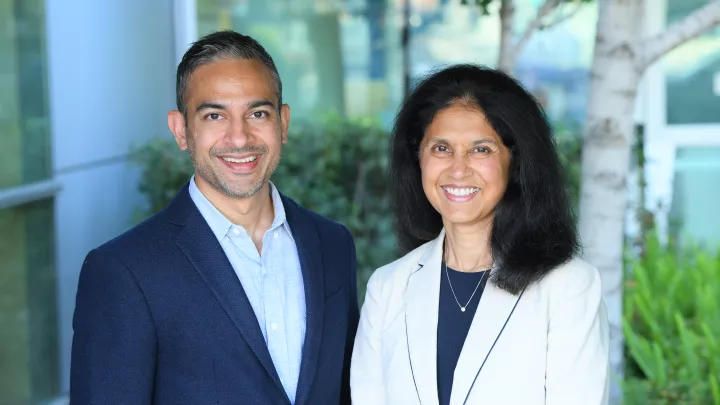Craniosynostosis Program
Craniosynostosis occurs when an infant’s skull bones close prematurely. This condition can cause an irregular head shape, distort facial features and put pressure on delicate tissue. Children’s Hospital Los Angeles is home to a multidisciplinary Craniosynostosis Program that delivers the highest level of care.
When you bring your child to Children’s Hospital, you are choosing one of the largest pediatric craniosynostosis programs in the country. We have some of the most experienced specialists in the area. These attributes help more children achieve excellent outcomes.
Our Pediatric Craniosynostosis Program: Why Choose Us
Our experts have treated thousands of children. We have performed some of the highest volumes of craniosynostosis and craniofacial surgeries in the country. We deliver gold-standard treatments for all craniosynostosis types.
At Children’s Hospital, your child has access to:
- Multidisciplinary approach: Craniosynostosis syndromes can affect the appearance of your child’s skull, face and eyes. That’s why your child’s craniosynostosis team includes experts in craniofacial plastic surgery, neurosurgery, developmental pediatrics, genetics and ophthalmology. These specialists collaborate to give your child the best possible outcomes—both in appearance and function.
- Coordinated, convenient care: Our patients see our whole craniosynostosis team in a single clinic visit. If additional specialist consultations are necessary, our craniofacial nurse practitioners can help. They coordinate appointments with the doctors your baby needs.
- Advanced craniosynostosis surgery: When appropriate, our surgeons use endoscopic synostosis correction. This approach involves tiny incisions and sophisticated instruments, so it’s gentler on growing bodies. We use this approach on children as young as three months old. Operating at a younger age may lower the risk of potential complications.
- Developmental testing and follow-up: Our psychologist provides developmental testing before surgery and at the six-, 12-, and 36-month marks after surgery. These assessments help ensure that your child stays on an optimal path of growth and development.
What Is Craniosynostosis?
Craniosynostosis is a condition that’s present at birth (congenital). Instead of skull bones that have gaps or “sutures” to accommodate brain growth, a child is born with fusion of one of more of these sutures, resulting in an abnormal shape of the skull.
Sometimes, craniosynostosis means a baby’s brain does not have room to grow. When this occurs, babies might experience a buildup of pressure in their skulls. The condition can also affect eye positioning and facial features. Surgery is often necessary to correct these issues.
A Craniosynostosis Surgery Story: For Walter to Feel Better
Shortly after Walter was born, his parents noticed his forehead jutting out from the rest of his head. Our multidisciplinary craniosynostosis team determined Walter needed surgery to reshape his skull. Within two weeks of the procedure, Walter’s skull had a more natural appearance. Strangers couldn’t even tell that he had undergone skull surgery. Today, Walter is healthy and growing as expected.
Types of Craniosynostosis We Treat
Our craniofacial surgeons care for children with all craniosynostosis types, including:
- Sagittal synostosis
- Coronal synostosis (both sides or just one side)
- Lambdoidal synostosis (both sides or just one side)
- Metopic synostosis
- Multi-sutural synostosis (more than one suture)
- Syndromic synostosis (Apert, Crouzon, Pfeiffer, Carpenter, Sathre-Chotzen, Muenke)
Craniosynostosis Treatment
Children’s Hospital offers the full range of craniosynostosis therapies, including:
Craniosynostosis Surgery
Babies with moderate to severe craniosynostosis often need surgery early in life. Surgery reshapes the head, providing room for the brain to grow normally.
Craniosynostosis surgery also helps your baby by:
- Decreasing the risk of high intracranial pressure
- Enhancing head shape and appearance
- Lowering the risk of developmental delays due to problems with brain growth
Endoscopic Synostosis Surgery
The endoscopic approach for synostosis surgery is most commonly done for sagittal synostosis on babies less than three months of age. It involves two small incisions on the head instead of larger ones. We pass tiny instruments and a camera through the incisions to carry out the procedure.
Benefits include:
- Faster recovery
- Less scarring
- Low complication rates
Helmet Therapy
Babies with positional plagiocephaly (a cranial deformity that is not treated surgically) typically benefit from helmet therapy It involves wearing a special helmet that gently reshapes the skull.
For the best results, we recommend helmet therapy during periods of brain growth and development. These growth periods typically occur during infancy and end before a child is two years old. We perform a detailed assessment to determine whether helmet therapy is right for your child.
Expert Craniosynostosis Treatment
Our craniosynostosis treatment team includes pediatric neurosurgeons, craniofacial plastic surgeons, ophthalmologists, geneticists and pediatricians with special training in children with congenital conditions. Having so many specialists in one program helps your child receive comprehensive, timely care. We also have a psychologist who provides developmental assessments to ensure that your child continues developing on a healthy path.


